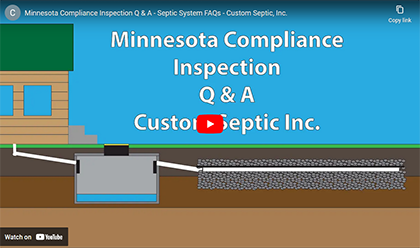What Do You Know About Onsite Septic Systems?
 Considering the importance of properly disposing of Sewage Contaminated Wastewater and the number of Septic Systems in Buffalo MN backyards, more information may be needed. Some Licensed Septic Contractors, including Custom Septic, Inc. (CSI) are experts in the design, operation, installation and repair of thousands of Minnesota On-site Sewer Systems. This article will hopefully answer some of the Frequently Asked Questions about Septic System Maintenance, Inspections and Failure Signs.
Considering the importance of properly disposing of Sewage Contaminated Wastewater and the number of Septic Systems in Buffalo MN backyards, more information may be needed. Some Licensed Septic Contractors, including Custom Septic, Inc. (CSI) are experts in the design, operation, installation and repair of thousands of Minnesota On-site Sewer Systems. This article will hopefully answer some of the Frequently Asked Questions about Septic System Maintenance, Inspections and Failure Signs.
Septic System FAQs | What Everyone Should Know
A well designed, installed and functioning Sewage Treatment System should last for decades if it is properly maintained. Keeping your Onsite Septic System healthy doesn’t take a whole lot of time or effort by the homeowner. Just keep up with regular inspections and follow the advice of your Licensed Septic System Contractors at Custom Septic, Inc. (CSI).
How Should I Maintain a Septic System?
Answer: Regular Maintenance is a great way to keep your septic system operating at its best. It is more cost effective to keep a system healthy than to pay for repairs or a septic system failure. The CSI website has a page dedicated to Septic System Maintenance. The following tips should give you an idea of maintenance do’s and don’ts.
A) Remember to have the Septic Tank Pumped out and cleaned periodically. A annual inspection is a good way to know when it is time to schedule a visit from a sewage pumping truck.
B) Avoid overloading your septic system will bacteria killing products including house cleaning products and soaps. Bacteria is necessary to digest solids inside of the tank. Avoid antibacteria soaps and use bleach and cleansers sparingly.
C) Don’t use your Toilet as a trash can. A buildup of inorganic materials can significantly slow down the natural treatment process or clog up the drainfield. Only human waste, water and toilet tissue should be flushed down the drain. A partial list of Flushing Don’ts is on our Septic System FAQ page under “What shouldn’t I flush down the toilet”.
D) Garbage Disposals send food particals and grease into the septic tank. Using a disposal will most likely increase the frequency of when the tank needs servicing.
E) Installing Washing Machine Lint Filters are a good way to prevent garment fibers from clogging up the septic system. Fibers build up inside to the tank since they cannot be digested by bacteria.
How Often Should a Septic Tank be Pumped?
Answer: The frequency of Septic Tank Pumping depends on several factors such as the size of the tank, effectiveness of bacteria inside of the tank and amount of wastewater entering the system. Generally speaking, a septic tank needs to be pumped out approximately once every three years.
Should I Use Septic Tank Additives?
Answer: Septic System Additives and Cleaners have not been proven to help the function of the septic tank. At best, they are usually a waste of time and money. At worst, they can actually disrupt and harm the inner workings of the organic treatment process.
MN Licensed Septic Contractor
Check back again for more Frequently Asked Questions about Buffalo MN septic systems. Part 2 will answer questions on Septic System Inspections. You can also check out the FAQ Page on Custom Septic, Inc. (CSI). We are a Licensed Septic Contractor with more than two decades of on the job experience and MPCA Certification.
Contact Custom Septic, Inc. (CSI) for Professional Septic System Inspections and Repairs at: (763) 218-4769

 Now Accepting Major Credit Cards!
Now Accepting Major Credit Cards!
